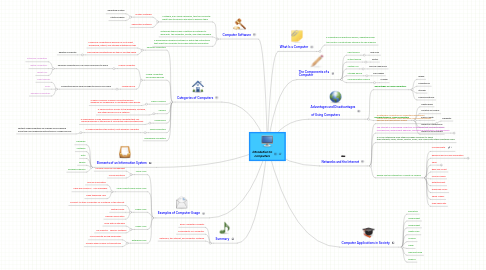
1. Categories of Computers
1.1. Personal computers
1.1.1. A personal computercan perform all of its input, processing, output, and storage activities by itself
1.1.2. Two popular architectures are the PC and the Apple
1.1.2.1. Desktop computer
1.2. Mobile computers and mobile devices
1.2.1. Mobile Computer
1.2.1.1. Personal computer you can carry from place to place
1.2.1.1.1. notebook computers
1.2.1.1.2. laptop computers
1.2.1.1.3. Tablet PCs
1.2.2. Mobile Device
1.2.2.1. Computing device small enough to hold in your hand
1.2.2.1.1. smart phones
1.2.2.1.2. PDAs
1.2.2.1.3. handheld computers
1.3. Game consoles
1.3.1. A game consoleis a mobile computing device designed for singleplayer or multiplayer video games
1.4. Servers
1.4.1. A servercontrols access to the hardware, software, and other resources on a network
1.5. Mainframes
1.5.1. A mainframeis a large, expensive, powerful computer that can handle hundreds or thousands of connected users simultaneously
1.6. Supercomputers
1.6.1. A supercomputeris the fastest, most powerful computer
1.6.1.1. Fastest supercomputers are capable of processing more than one quadrillion instructions in a single second
1.7. Embedded computers
2. Elements of an Information System
2.1. Hardware
2.2. Software
2.3. Data
2.4. People
2.5. PeopleProcedures
3. Computer Software
3.1. Software, also called a program, tells the computer what tasks to perform and how to perform them
3.1.1. System Software
3.1.1.1. Operating system
3.1.1.2. Utility program
3.1.2. Application Software
3.2. Installingis the process of setting up software to work with the computer, printer, and other hardware
3.3. A programmer develops software or writes the instructions that direct the computer to process data into information
4. Examples of Computer Usage
4.1. Home User
4.1.1. Personal financial management
4.1.2. Communications
4.2. Small Office/Home Office User
4.2.1. Look up information
4.2.2. Send and receive e‐mail messages
4.2.3. Make telephone calls
4.3. Mobile User
4.3.1. Connect to other computers on a network or the Internet
4.3.2. Watch movies
4.3.3. Transfer information
4.4. Power User
4.4.1. Work with multimedia
4.4.2. Use industry‐specific software
4.5. Enterprise User
4.5.1. Communicate among employees
4.5.2. Process high volumes of transactions
5. Summary
5.1. Basic computer concepts
5.2. Components of a computer
5.3. Networks, the Internet, and computer software
6. What Is a Computer
6.1. A computeris an electronic device, operating under the control of instructions stored in its own memory
7. Advantages and Disadvantages of Using Computers
7.1. Advantages of Using Computers
7.1.1. Speed
7.1.2. Consistency
7.1.3. Storage
7.1.4. Communications
7.2. Disadvantages of Using Computers
7.2.1. Health Risks
7.2.2. Violation of Privacy
7.2.3. Public Safety
7.2.4. Impact on Labor Force
7.2.5. Impact on Envronment
8. Networks and the Internet
8.1. A networkis a collection of computers and devices connected together, often wirelessly,via communications devices and transmission media
8.1.1. Reliability
8.2. The Internet is a worldwide collection of networks that connects million of businesses, government agencies, educational institutions, and individuals
8.2.1. INS to insert (Windows)
8.2.2. TAB to insert (Mac OS)
8.2.3. ENTER to add siblings
8.2.4. DEL to delete
8.2.5. All key shortcuts
8.3. A social networking Web siteencourages members to share their interests, ideas, stories, photos, music, and videos with other registered users
8.4. People use the Internet for a variety of reasons
8.4.1. Communicate
8.4.2. Research and Access Information
8.4.2.1. Personal Todo List
8.4.2.2. Vacation Planning
8.4.2.3. Meeting Minutes
8.4.2.4. Project Plan
8.4.2.5. more...
8.4.3. Shop
8.4.3.1. Offline Mode
8.4.3.2. Geistesblitz Tools
8.4.3.3. Email & SMS Gateways
8.4.3.4. Compare Editions
8.4.4. Bank and Invest
8.4.5. Online Trading
8.4.6. Entertainment
8.4.7. Download Music
8.4.8. Share Videos
8.4.9. Web Applicatin
9. The Components of a Computer
9.1. Input Device
9.1.1. Wab cam
9.2. Output device
9.2.1. Printer
9.3. System Uni
9.3.1. Process memmory
9.4. Storage Device
9.4.1. Card reader
9.5. Communication Device
9.5.1. Modem
